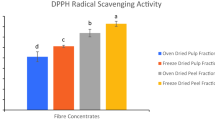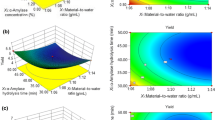Abstract
A 50 % increase in the content of water-soluble dietary fibers from carrot residues (CRSDF) was obtained by a novel blasting extrusion processing (BEP) with improved water holding capacity and oil retention capacity. A neutral polysaccharide (CRSDF-2) was successfully separated by a DEAE-52-cellulose column chromatography system. The results of high-performance liquid chromatography (HPLC) and gas chromatography (GC) showed that CRSDF-2 contained four sorts of monosaccharides: arabinose, xylose, glucose, and galactose with a molar ratio of 0.58:1.50:1.0:2.02. The average molecular weight of CRSDF-2 was estimated to be approximately 5.98 × 104 Da. Moreover, it was illustrated that CRSDF displayed a high cation-exchange capacity and a high adsorption capacity for Pb cation. Furthermore, CRSDF was capable of binding sodium deoxycholate sodium cholate, sodium deoxycholate, and sodium taurocholate. CRSDF could be potentially used as a promising ingredient in functional food and pharmaceutical industries.





Similar content being viewed by others
References
Abdul-Hamid, A., & Luan, Y. S. (2000). Functional properties of dietary fibre prepared from defatted rice bran. Food Chemistry, 68(1), 15–19.
Afify, A. E.-M. M., Romeilah, R. R., Osfor, M. M., & Elbahnasawy, A. S. (2013). Evaluation of carrot pomace (Daucus carota L.) as hypocholesterolemic and hypolipidemic agent on albino rats. Notulae Scientia Biologicae, 5(1), 7–14.
Brownlee, I. A. (2011). The physiological roles of dietary fibre. Food Hydrocolloids, 25(2), 238–250.
Burton-Freeman, B. (2000). Dietary fiber and energy regulation. The Journal of Nutrition, 130(2), 272S–275S.
Chau, C.-F., & Chen, C.-H. (2006). Effects of two pomace insoluble fibres on the activities of faecal bacterial enzymes and intestinal health. European Food Research and Technology, 222(5–6), 681–685.
Chau, C.-F., Chen, C.-H., & Lee, M.-H. (2004). Comparison of the characteristics, functional properties, and in vitro hypoglycemic effects of various carrot insoluble fiber-rich fractions. LWT- Food Science and Technology, 37(2), 155–160.
Chau, C.-F., Wang, Y.-T., & Wen, Y.-L. (2007). Different micronization methods significantly improve the functionality of carrot insoluble fibre. Food Chemistry, 100(4), 1402–1408.
Chen, H., Zhang, M., Qu, Z., & Xie, B. (2008). Antioxidant activities of different fractions of polysaccharide conjugates from green tea (Camellia sinensis). Food Chemistry, 106(2), 559–563.
Chen, J., Gao, D., Yang, L., & Gao, Y. (2013). Effect of microfluidization process on the functional properties of insoluble dietary fiber. Foodservice Research International, 54(2), 1821–1827.
Chen, Y., Ye, R., & Liu, J. (2014a). Effects of different concentrations of ethanol and isopropanol on physicochemical properties of zein-based films. Industrial Crops and Products, 53, 140–147.
Chen, Y., Ye, R., Yin, L., & Zhang, N. (2014b). Novel blasting extrusion processing improved the physicochemical properties of soluble dietary fiber from soybean residue and in vivo evaluation. Journal of Food Engineering, 120, 1–8.
Chen, Y., Ye, R., & Wang, Y. (2015). Acid-soluble and pepsin-soluble collagens from grass carp (ctenopharyngodon idella) skin: a comparative study on physicochemical properties. International Journal of Food Science and Technology, 50(1), 186–193.
Cheng, Z., Wu, C., Yang, W., & Xu, T. (2010). Preparation of bromomethylated poly (2, 6-dimethyl-1, 4-phenylene oxide) hollow fiber cation-exchange membranes and immobilization of cellulase thereon. Journal of Membrane Science, 358(1), 93–100.
Cui, S. W., Phillips, G. O., Blackwell, B., & Nikiforuk, J. (2007). Characterisation and properties of Acacia senegal (L.) Willd. var. senegal with enhanced properties (Acacia (sen) SUPERGUM™): part 4. Spectroscopic characterisation of Acacia senegal var. senegal and Acacia (sen) SUPERGUM™ Arabic. Food Hydrocolloids, 21(3), 347–352.
Daşbaşı, T., Saçmacı, Ş., Ülgen, A., & Kartal, Ş. (2015). A solid phase extraction procedure for the determination of Cd (II) and Pb (II) ions in food and water samples by flame atomic absorption spectrometry. Food Chemistry, 174, 591–596.
Debruyne, P. R., Bruyneel, E. A., Li, X., Zimber, A., Gespach, C., & Mareel, M. M. (2001). The role of bile acids in carcinogenesis. Mutation Research, Fundamental and Molecular Mechanisms of Mutagenesis, 480, 359–369.
Ebihara, K., & Schneeman, B. O. (1989). Interaction of bile acids, phospholipids, cholesterol and triglyceride with dietary fibers in the small intestine of rats. The Journal of Nutrition, 119(8), 1100–1106.
Elleuch, M., Bedigian, D., Roiseux, O., Besbes, S., Blecker, C., & Attia, H. (2011). Dietary fibre and fibre-rich by-products of food processing: characterisation, technological functionality and commercial applications: a review. Food Chemistry, 124(2), 411–421.
Faraj, A., Vasanthan, T., & Hoover, R. (2004). The effect of extrusion cooking on resistant starch formation in waxy and regular barley flours. Foodservice Research International, 37(5), 517–525.
Feng, T., Su, Q., Zhuang, H., Ye, R., Gu, Z., & Jin, Z. (2014). Ghost structures, pasting, rheological and textural properties between mesona blumes gum and various starches. Journal of Food Quality, 37(2), 73–82.
Galanakis, C. M., Tornberg, E., & Gekas, V. (2010). Dietary fiber suspensions from olive mill wastewater as potential fat replacements in meatballs. LWT- Food Science and Technology, 43(7), 1018–1025.
Grant, G. T., Morris, E. R., Rees, D. A., Smith, P. J., & Thom, D. (1973). Biological interactions between polysaccharides and divalent cations: the egg-box model. FEBS Letters, 32(1), 195–198.
Hernández-Ortega M, Kissangou G, Necoechea-Mondragón H, Sánchez-Pardo ME & Ortiz-Moreno A (2013) Microwave Dried Carrot Pomace as a Source of Fiber and Carotenoids.
Hu, Y.-B., Wang, Z., & Xu, S.-Y. (2008). Corn bran dietary fibre modified by xylanase improves the mRNA expression of genes involved in lipids metabolism in rats. Food Chemistry, 109(3), 499–505.
Hu, G., Huang, S., Chen, H., & Wang, F. (2010). Binding of four heavy metals to hemicelluloses from rice bran. Foodservice Research International, 43(1), 203–206.
Huang, Z., Ye, R., Chen, J., & Xu, F. (2013). An improved method for rapid quantitative analysis of the insoluble dietary fiber in common cereals and some sorts of beans. Journal of Cereal Science, 57(3), 270–274.
Ingelsson, E., Schaefer, E. J., Contois, J. H., McNamara, J. R., Sullivan, L., Keyes, M. J., Pencina, M. J., Schoonmaker, C., Wilson, P. W., & D’Agostino, R. B. (2007). Clinical utility of different lipid measures for prediction of coronary heart disease in men and women. Journal of the American Medical Association, 298(7), 776–785.
Jabbar, S., Abid, M., Wu, T., Hashim, M. M., Saeeduddin, M., Hu, B., Lei, S., & Zeng, X. (2015). Ultrasound-assisted extraction of bioactive compounds and antioxidants from carrot pomace: a response surface approach. Journal of Food Processing and Preservation.
Kahlon, T., Chiu, M., & Chapman, M. (2009). In vitro bile-acid-binding of whole vs. pearled wheat grain. Cereal Chemistry, 86(3), 329–332.
Kendall, C. W., Esfahani, A., & Jenkins, D. J. (2010). The link between dietary fibre and human health. Food Hydrocolloids, 24(1), 42–48.
Ma, G., Yang, W., Mariga, A. M., Fang, Y., Ma, N., Pei, F., & Hu, Q. (2014). Purification, characterization and antitumor activity of polysaccharides from Pleurotus eryngii residue. Carbohydrate Polymers, 114, 297–305.
Nawirska, A. (2005). Binding of heavy metals to pomace fibers. Food Chemistry, 90(3), 395–400.
Nawirska, A., & Kwaśniewska, M. (2005). Dietary fibre fractions from fruit and vegetable processing waste. Food Chemistry, 91(2), 221–225.
Ou, S., Gao, K., & Li, Y. (1999). An in vitro study of wheat bran binding capacity for Hg, Cd, and Pb. Journal of Agricultural and Food Chemistry, 47(11), 4714–4717.
Ozcan, M. M., Dursun, N., & Sağlam, C. (2011). Heavy metals bounding ability of pomegranate (Punica granatum) peel in model system. International Journal of Food Properties, 14(3), 550–556.
Sánchez-Castillo, C. P., Dewey, P. J., Ma, D. L. S., Finney, S., & James, W. P. T. (1995). The dietary fiber content (nonstarch polysaccharides) of Mexican fruits and vegetables. Journal of Food Composition and Analysis, 8(3), 284–294.
Sangnark, A., & Noomhorm, A. (2003a). Effect of particle sizes on functional properties of dietary fibre prepared from sugarcane bagasse. Food Chemistry, 80(2), 221–229.
Sangnark, A., & Noomhorm, A. (2003b). Effect of particle sizes on in-vitro calcium and magnesium binding capacity of prepared dietary fibers. Foodservice Research International, 36(1), 91–96.
Sharma, K. D., Karki, S., Thakur, N. S., & Attri, S. (2012). Chemical composition, functional properties and processing of carrot—a review. Journal of Food Science and Technology, 49(1), 22–32.
Tharanathan, R., & Mahadevamma, S. (2003). Grain legumes—a boon to human nutrition. Trends in Food Science and Technology, 14(12), 507–518.
Upadhyay, A., Sharma, H., & Sarkar, B. (2010). Optimization of carrot pomace powder incorporation on extruded product quality by response surface methodology. Journal of Food Quality, 33(3), 350–369.
Vasanthan, T., Gaosong, J., Yeung, J., & Li, J. (2002). Dietary fiber profile of barley flour as affected by extrusion cooking. Food Chemistry, 77(1), 35–40.
Villanueva-Suárez, M. J., Pérez-Cózar, M. L., & Redondo-Cuenca, A. (2013). Sequential extraction of polysaccharides from enzymatically hydrolyzed okara byproduct: physicochemical properties and in vitro fermentability. Food Chemistry, 141(2), 1114–1119.
Viuda-Martos, M., López-Marcos, M., Fernández-López, J., Sendra, E., López-Vargas, J., & Pérez-Álvarez, J. (2010). Role of fiber in cardiovascular diseases: a review. Comprehensive Reviews in Food Science and Food Safety, 9(2), 240–258.
Yan, X., Ye, R., & Chen, Y. (2015). Blasting extrusion processing: the increase of soluble dietary fiber content and extraction of soluble-fiber polysaccharides from wheat bran. Food Chemistry, 180, 106–115.
Yoon, K. Y., Cha, M., Shin, S. R., & Kim, K. S. (2005). Enzymatic production of a soluble-fibre hydrolyzate from carrot pomace and its sugar composition. Food Chemistry, 92(1), 151–157.
Zhang, M., Bai, X., & Zhang, Z. (2011). Extrusion process improves the functionality of soluble dietary fiber in oat bran. Journal of Cereal Science, 54(1), 98–103.
Acknowledgments
This research was kindly supported by the Projects of Tianjin Science and Technology Support Program (Number: 13ZXNZNC08500).
Author information
Authors and Affiliations
Corresponding authors
Rights and permissions
About this article
Cite this article
Gao, A., Yan, X., Xu, X. et al. Physicochemical and Bioactive Properties of Soluble Dietary Fibers from Blasting Extrusion Processing (BEP)-Extruded Carrot Residues. Food Bioprocess Technol 8, 2036–2046 (2015). https://doi.org/10.1007/s11947-015-1557-1
Received:
Accepted:
Published:
Issue Date:
DOI: https://doi.org/10.1007/s11947-015-1557-1




